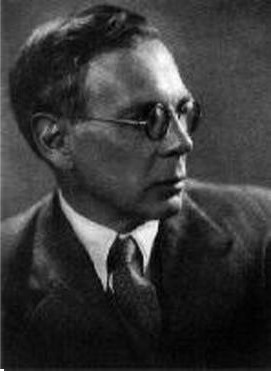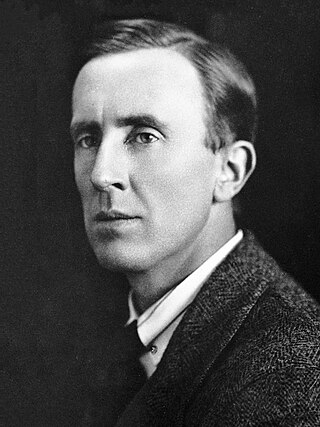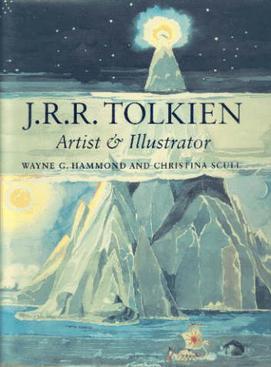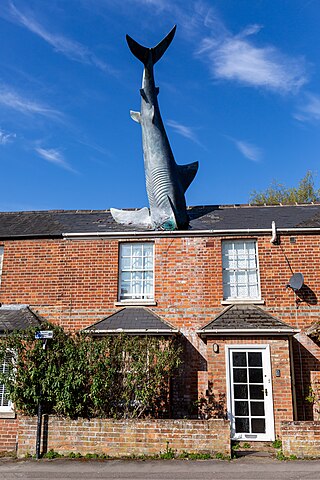
Sandfield Road is a road in the suburb of Headington, Oxford, England. [2] It is close to the John Radcliffe Hospital. It was home to author and academic J. R. R. Tolkien in the 1950s and 1960s.

Sandfield Road is a road in the suburb of Headington, Oxford, England. [2] It is close to the John Radcliffe Hospital. It was home to author and academic J. R. R. Tolkien in the 1950s and 1960s.
Hugo Dyson, a member of the Oxford literary group called the Inklings, lived at 32 Sandfield Road until his death in 1975. [3]
Sandfield Road's most famous resident was the author and academic J. R. R. Tolkien, another member of the Inklings, who lived at No 76 with his wife Edith from 1953 to 1968, towards the end of his time in Oxford. [3] [4] [5] There is an inscription above the garage. [6] When living here, Tolkien attended the Catholic Church of St Anthony of Padua in nearby Headley Way. [7] Tolkien previously lived in Northmoor Road, North Oxford, and Holywell Street, in central Oxford. The following volumes of Tolkien's The Lord of the Rings novel were first published while he lived in this house:
Tolkien attended the Church of St Anthony of Padua nearby (opened in 1960) when he was a resident in Sandfield Road. In due course, Tolkien's private address at Sandfield Road received some publicity and his telephone number was in the Oxford telephone directory. [4] In 1968, partly due to harassment by fans at his home in Sandfield Road, Tolkien moved to Bournemouth on the south coast of England. [8]
W. H. Auden, an admirer of Tolkien, described his Sandfield Road house by reportedly stating "He lives in a hideous house, I can't tell you how awful it is — with hideous pictures on the walls." [4] [9]
Sandfield Day Nursery is in Sandfield Road. [10]

Charles Walter Stansby Williams was an English poet, novelist, playwright, theologian and literary critic. Most of his life was spent in London, where he was born, but in 1939 he moved to Oxford with the university press for which he worked until his death.

John Ronald Reuel Tolkien was an English writer and philologist. He was the author of the high fantasy works The Hobbit and The Lord of the Rings.

The Inklings were an informal literary discussion group associated with J. R. R. Tolkien and C. S. Lewis at the University of Oxford for nearly two decades between the early 1930s and late 1949. The Inklings were literary enthusiasts who praised the value of narrative in fiction and encouraged the writing of fantasy. The best-known, apart from Tolkien and Lewis, were Charles Williams, and Owen Barfield.

Humphrey William Bouverie Carpenter was an English biographer, writer, and radio broadcaster. He is known especially for his biographies of J. R. R. Tolkien and other members of the literary society the Inklings. He won a Mythopoeic Award for his book The Inklings in 1982.

The Eagle and Child, nicknamed "the Bird and Baby", is a pub in St Giles', Oxford, England, owned by the Ellison Institute of Technology and previously operated by Mitchells & Butlers as a Nicholson's pub. The pub had been part of an endowment belonging to University College since the 17th century. It has associations with the Inklings writers' group which included J. R. R. Tolkien and C. S. Lewis. In 2005, 25 other pubs in the United Kingdom had the same name.

Thomas Alan Shippey is a British medievalist, a retired scholar of Middle and Old English literature as well as of modern fantasy and science fiction. He is considered one of the world's leading academic experts on the works of J. R. R. Tolkien about whom he has written several books and many scholarly papers. His book The Road to Middle-Earth has been called "the single best thing written on Tolkien".

J. R. R. Tolkien: Artist and Illustrator is a collection of paintings and drawings by J. R. R. Tolkien for his stories, published posthumously in 1995. The book was edited by Wayne G. Hammond and Christina Scull. It won the 1996 Mythopoeic Scholarship Award for Inklings Studies. The nature and importance of Tolkien's artwork is discussed.

The Mythopoeic Awards for literature and literary studies are given annually for outstanding works in the fields of myth, fantasy, and the scholarly study of these areas. Established by the Mythopoeic Society in 1971, the Mythopoeic Fantasy Award is given for "fiction in the spirit of the Inklings", and the Scholarship Award for non-fiction work. The award is a statuette of a seated lion, with a plaque on the base. It has drawn resemblance to, and is often called, the "Aslan".
The works of J. R. R. Tolkien have generated a body of research covering many aspects of his fantasy writings. These encompass The Lord of the Rings and The Silmarillion, along with his legendarium that remained unpublished until after his death, and his constructed languages, especially the Elvish languages Quenya and Sindarin. Scholars from different disciplines have examined the linguistic and literary origins of Middle-earth, and have explored many aspects of his writings from Christianity to feminism and race.
"Errantry" is a three-page poem by J.R.R. Tolkien, first published in The Oxford Magazine in 1933. It was included in revised and extended form in Tolkien's 1962 collection of short poems, The Adventures of Tom Bombadil. Donald Swann set the poem to music in his 1967 song cycle, The Road Goes Ever On.

Headington is an eastern suburb of Oxford, in the county of Oxfordshire, England. It is at the top of Headington Hill overlooking the city in the Thames valley below, and bordering Marston to the north-west, Cowley to the south, and Barton and Risinghurst to the east. The life of the large residential area is centred upon London Road, the main road between London and Oxford.

Henry Victor Dyson Dyson, generally known as Hugo Dyson and who signed his writings H. V. D. Dyson, was an English academic and a member of the Inklings literary group. He was a committed Christian, and together with J. R. R. Tolkien he helped C. S. Lewis to convert to Christianity, particularly after a long conversation as they strolled on Addison's Walk at Oxford.

Holywell Street is a street in central Oxford, England. It runs east–west with Broad Street to the west and Longwall Street to the east. About halfway along, Mansfield Road adjoins to the north.

Northmoor Road is a residential street in North Oxford, England.
Colin Duriez is an English writer on fantasy, especially that of the Inklings literary group centred around the Christian authors C. S. Lewis and J. R. R. Tolkien.
J. R. R. Tolkien's fantasy books on Middle-earth, especially The Lord of the Rings and The Silmarillion, drew on a wide array of influences including language, Christianity, mythology, archaeology, ancient and modern literature, and personal experience. He was inspired primarily by his profession, philology; his work centred on the study of Old English literature, especially Beowulf, and he acknowledged its importance to his writings.
Middle-earth is the setting of much of the English writer J. R. R. Tolkien's fantasy. The term is equivalent to the Miðgarðr of Norse mythology and Middangeard in Old English works, including Beowulf. Middle-earth is the oecumene in Tolkien's imagined mythological past. Tolkien's most widely read works, The Hobbit and The Lord of the Rings, are set entirely in Middle-earth. "Middle-earth" has also become a short-hand term for Tolkien's legendarium, his large body of fantasy writings, and for the entirety of his fictional world.

The Church of St Anthony of Padua, Oxford is a yellow brick-built Catholic church in suburb of Headington, east Oxford, Oxfordshire, England. The church building is located in Headley Way.

Jared Charles Lobdell was an American author and one of the first Tolkien scholars. He is best known for some thirty academic books on American history and the Inklings including J. R. R. Tolkien, C. S. Lewis, and Charles Williams.
John Garth is a British journalist and author, known especially for writings about J. R. R. Tolkien including his biography Tolkien and the Great War and a book on the places that inspired Middle-earth, The Worlds of J. R. R. Tolkien. He won a 2004 Mythopoeic Award for Scholarship for his work on Tolkien. The biography influenced much Tolkien scholarship in the subsequent decades.
{{cite book}}: |work= ignored (help)